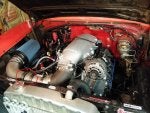Considering another route for my 4" stroked, L92 headed, Erson cam'd (234/242 duration @ .050", .621"lift) LQ4. I originally ran it with an LS3 intake for a year, then switched to a Holley Hi-Ram for the last two. It's basically a 1/4 mile warrior that's driven to the track. Tranny is a 4L80E with a converter that flashes to about 4600, 3.89 gears.
The Hi-Ram dyno'd at 20 HP more than the LS3, but in the process lost some low end (60' times dropped of slightly, but ETs were slightly better). I shift at 6300 (cam card says powerband is to 7000, but it drops off well before that). Reasons I'm considering an intake change is to get some of the low end back (the Hi Ram is more intake than I need), and to be able to mount my wiper motor again (got caught in a HUGE rainstorm last year with no wipers - RainX is only good to a point).
Here are links to the three intakes (I verified Summit's info was correct on the Edelbrock and Holley websites):
Super Victor:
https://www.summitracing.com/parts/edl-28265
Victor Jr.:
https://www.summitracing.com/parts/edl-28455
Holley Mid Rise:
https://www.summitracing.com/parts/hly-300-136
All use a 4150 mount base. I'd use this elbow for my current 92mm Big Mouth TB:
https://www.summitracing.com/parts/hly-300-240
The vacuum source options are attractive on that elbow.
Not sure what the difference is between the Super Victor and Victor Jr. They both have the same listed powerband. The Holley powerband claim would seem more in line with what I've seen from my engine. My converter should get me immediately into the powerband of any of the intakes. (For comparison, according to Holley the Hi Ram powerband is idle-8000 - I believe the 8000 part, but not the idle part.)
Curious if there is any experience here with any of these intakes. FWIW, my son used the Holley cathedral port intake with an Edelbrock TB elbow, 92mm TB on his 5.7 LS, it ran better than it did with an LS2 intake.
The Hi-Ram dyno'd at 20 HP more than the LS3, but in the process lost some low end (60' times dropped of slightly, but ETs were slightly better). I shift at 6300 (cam card says powerband is to 7000, but it drops off well before that). Reasons I'm considering an intake change is to get some of the low end back (the Hi Ram is more intake than I need), and to be able to mount my wiper motor again (got caught in a HUGE rainstorm last year with no wipers - RainX is only good to a point).
Here are links to the three intakes (I verified Summit's info was correct on the Edelbrock and Holley websites):
Super Victor:
https://www.summitracing.com/parts/edl-28265
Victor Jr.:
https://www.summitracing.com/parts/edl-28455
Holley Mid Rise:
https://www.summitracing.com/parts/hly-300-136
All use a 4150 mount base. I'd use this elbow for my current 92mm Big Mouth TB:
https://www.summitracing.com/parts/hly-300-240
The vacuum source options are attractive on that elbow.
Not sure what the difference is between the Super Victor and Victor Jr. They both have the same listed powerband. The Holley powerband claim would seem more in line with what I've seen from my engine. My converter should get me immediately into the powerband of any of the intakes. (For comparison, according to Holley the Hi Ram powerband is idle-8000 - I believe the 8000 part, but not the idle part.)
Curious if there is any experience here with any of these intakes. FWIW, my son used the Holley cathedral port intake with an Edelbrock TB elbow, 92mm TB on his 5.7 LS, it ran better than it did with an LS2 intake.







